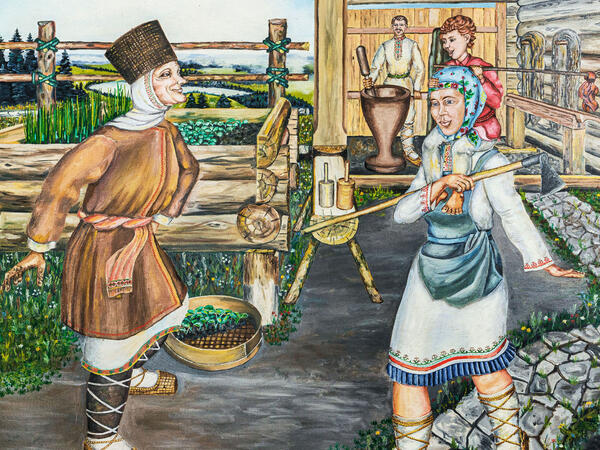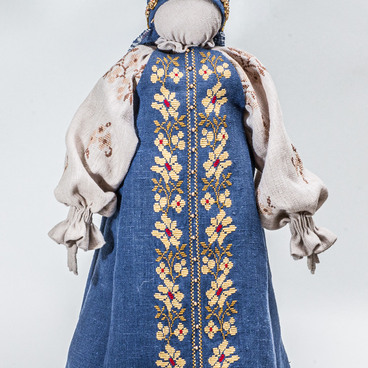Echik Bartsev’s works mostly include genre scenes from the life of a Mari village, depicting the traditions and everyday life of these people. The plot of the painting “Where is This Rider Going so Fast?” was described by the artist himself in his autobiography,
Where is This Rider Going so Fast?
Creation period
2001
Technique
oil, canvas
Collection
Exhibition
1
Open in app#8
Echik Bartsev
Where is This Rider Going so Fast?
#10
#13
My relative”s wife is going to work, she is small in stature. A red-haired grandson is sitting on her shoulders, almost as tall as she is. It was very funny to look at them, anfd then there is this grandson’s smile with a grimace, he is both ashamed and wants to show his tongue. Beyond that, a corner of country household, wares, nature.
#12
In the foreground, Bartsev depicted two Mari women in national costumes. The elderly woman on the left is dressed in an embroidered tunic and frockcoat. She has a magpie on her head and bast shoes on her feet. The woman on the right is depicted in a tunic with an apron, with a headscarf on her head, and a hoe in her right hand. A child sits on her shoulders. It was this child that Bartsev called the rider. The boy holds a stick with a red piece of cloth in his hands, which imitates a whip used to control a horse.
In the background of the picture, there is a greenhouse with seedlings and a shed, in which a man crushes flax seeds in a mortar. To the right, Bartsev depicted boards for drying flax and a flax-breaking machine; to the left there are timber trestles with pestles on top of them.
Echik Bartsev was born on May 9, 1936, in the village of Kugu-Kozhloyal in the Republic of Mari El. The artist reminisced that people from his village lived by subsistence farming. The locals did agricultural work, made all houseware by themselves, made bast shoes, wove, and embroidered. On holidays, all the villagers went to visit their neighbors.
In the background of the picture, there is a greenhouse with seedlings and a shed, in which a man crushes flax seeds in a mortar. To the right, Bartsev depicted boards for drying flax and a flax-breaking machine; to the left there are timber trestles with pestles on top of them.
Echik Bartsev was born on May 9, 1936, in the village of Kugu-Kozhloyal in the Republic of Mari El. The artist reminisced that people from his village lived by subsistence farming. The locals did agricultural work, made all houseware by themselves, made bast shoes, wove, and embroidered. On holidays, all the villagers went to visit their neighbors.
#11
Eric Bartsev. Photograph: “Gamayun” Museum Center
#7
There were seven children in the Bartsev family. During the war, the artist’s mother died, his father died at the front, so Eric grew up early. After serving in the army, he mastered many professions: he worked as a motorist, grab driver, concrete worker, electrician, driver, tractor driver, combine harvester, bulldozer operator, technician, and a design engineer.
Since 1964, Bartsev has been living in Yekaterinburg. In 1994, he retired and from that time began to draw. In his autobiography, he wrote,
Since 1964, Bartsev has been living in Yekaterinburg. In 1994, he retired and from that time began to draw. In his autobiography, he wrote,
#14
The second circle of my life is painting. That is why, my symbol of life was born like from two circles, besides they are the first and last letters of the word “Erdene”, which means “In the Morning” in translation from our Mari language.
#9
Ministry of Culture of the Russian Federation
read morehide
00:00
00:00
1x
Where is This Rider Going so Fast?
Creation period
2001
Technique
oil, canvas
Collection
Exhibition
1
Open in app
Share




